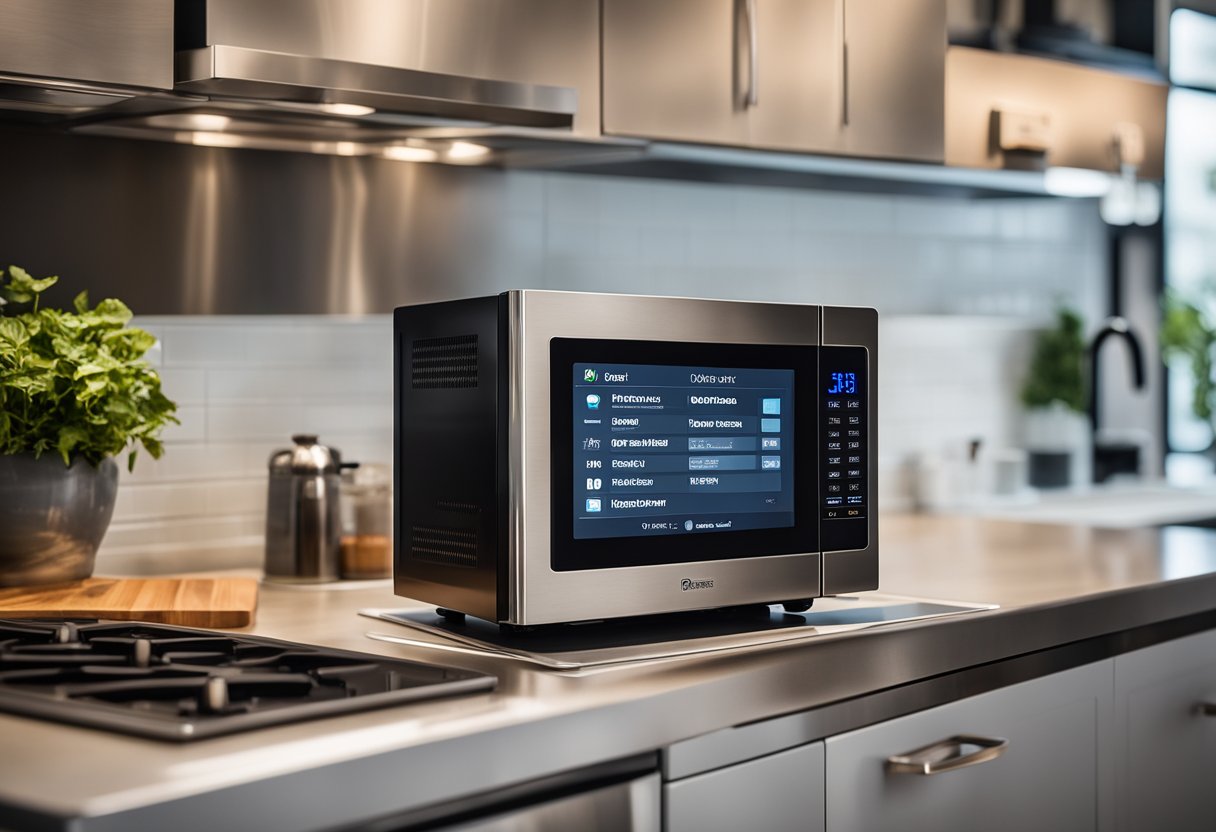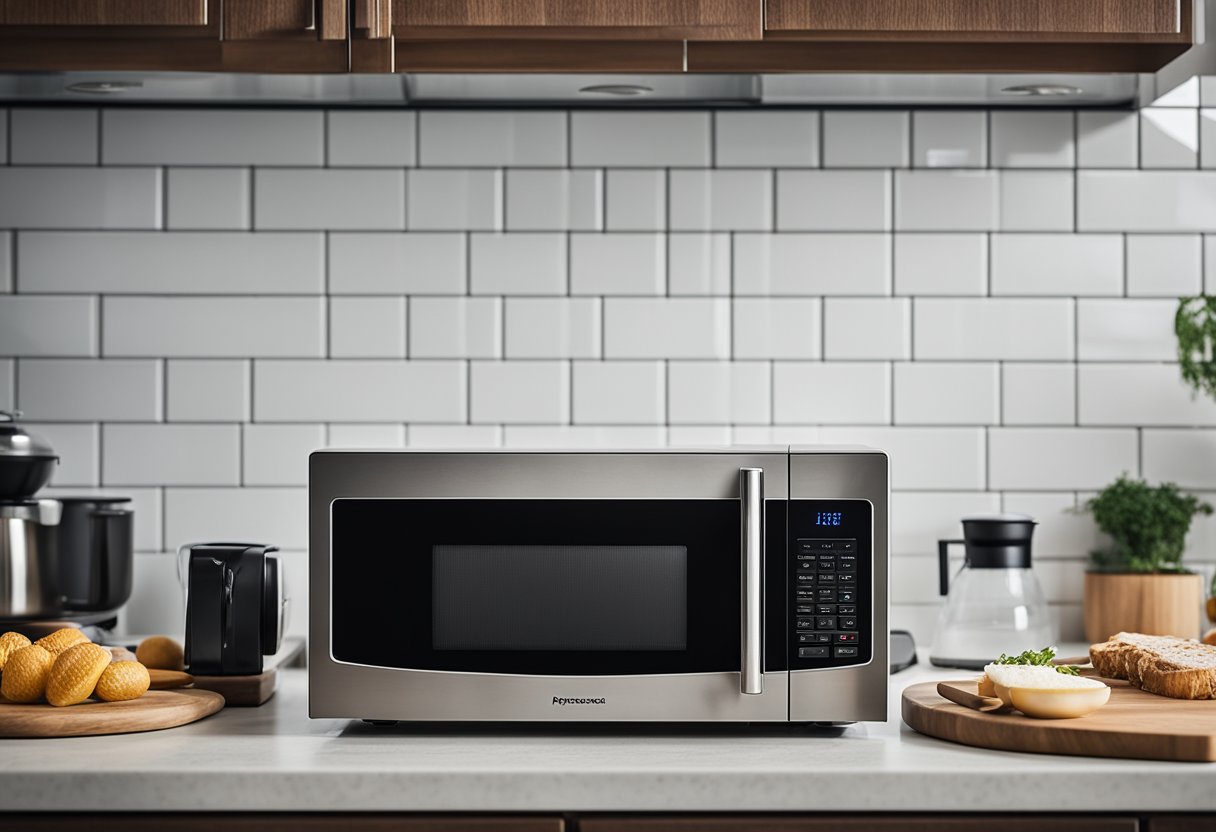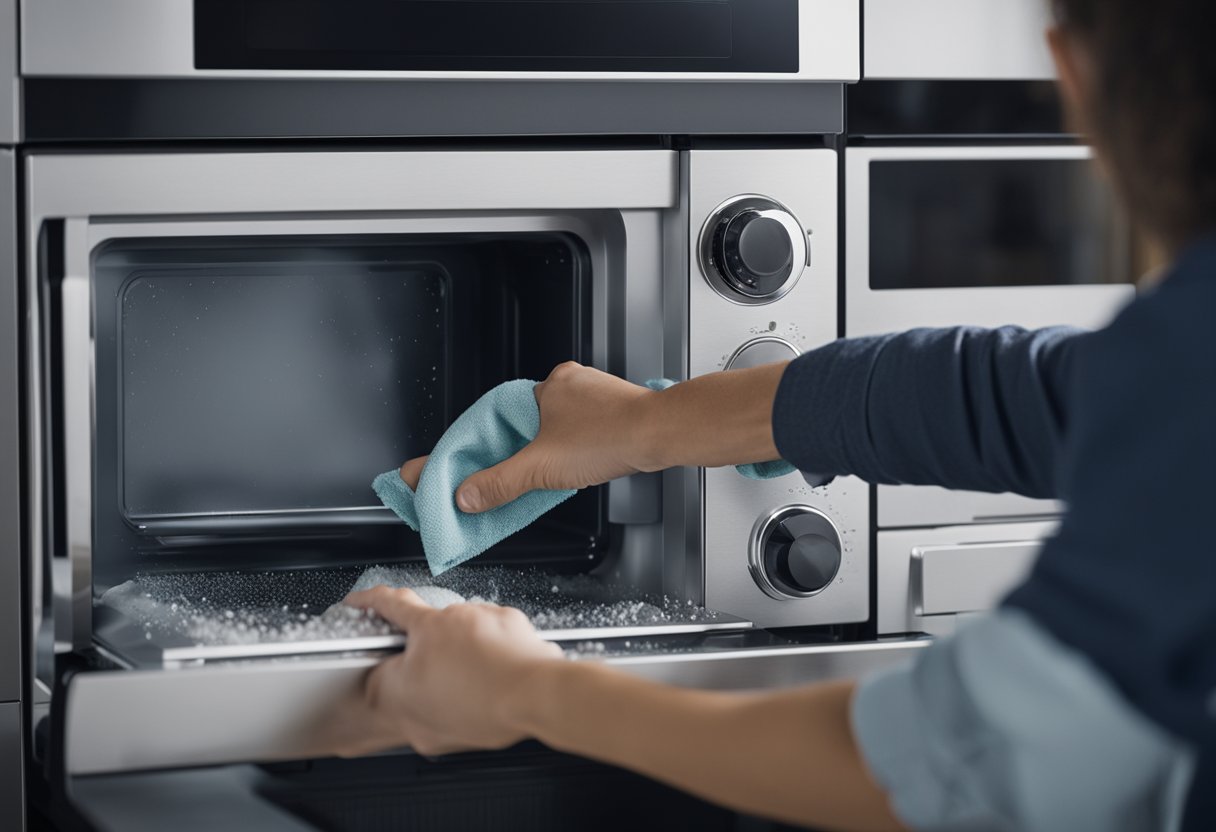Microwaves are a common kitchen appliance that have revolutionized the way people cook and reheat food. These devices use electromagnetic radiation to heat and cook food quickly and efficiently. They are a staple in many households, offering convenience and versatility for a wide range of cooking needs.
Understanding how microwaves work is essential to maximize their potential in the kitchen. The design and features of microwaves vary, with different types available to suit diverse cooking preferences and space requirements. From installation and use to cooking techniques and smart features, microwaves offer a multitude of functions to simplify meal preparation.
Key Takeaways
- Microwaves use electromagnetic radiation to heat and cook food quickly and efficiently.
- Different types of microwaves are available to suit diverse cooking preferences and space requirements.
- Microwaves offer a multitude of functions to simplify meal preparation, from cooking techniques to smart features.
Understanding Microwaves
Microwave Technology
Microwave technology is a type of electromagnetic radiation that is used for communication, cooking, and other applications. It is a form of non-ionizing radiation that has a frequency range of 300 MHz to 300 GHz. Microwaves are used in microwave ovens, telecommunication systems, and radar systems.
Types of Microwaves
There are two types of microwave ovens: standard and inverter. Standard microwaves use a transformer to convert the high voltage from the power source to a lower voltage that is used to power the magnetron, which generates the microwaves. Inverter microwaves use a different technology to generate microwaves. They use an inverter to convert the high voltage from the power source to a lower voltage that is used to power the magnetron. This technology allows for more precise control of the microwave power, resulting in more even cooking.
How Microwaves Work
Microwaves work by using electromagnetic radiation to heat food. The microwaves generated by the magnetron in the microwave oven are absorbed by the food, causing water molecules in the food to vibrate. This vibration causes friction between the water molecules, which generates heat. The heat generated by the friction cooks the food.
In summary, microwaves are a type of electromagnetic radiation that is used for communication, cooking, and other applications. There are two types of microwave ovens: standard and inverter. Standard microwaves use a transformer to convert the high voltage from the power source to a lower voltage that is used to power the magnetron, while inverter microwaves use an inverter to convert the high voltage from the power source to a lower voltage that is used to power the magnetron. Microwaves work by using electromagnetic radiation to heat food, causing water molecules in the food to vibrate and generate heat.
Design and Features
Size and Capacity
When choosing a microwave, it is essential to consider the size and capacity that best suits your needs. Countertop microwaves are available in various sizes, typically ranging from 0.5 to 2.2 cubic feet. Larger capacity microwaves are suitable for families or individuals who frequently cook or reheat larger portions. Compact microwaves are ideal for smaller kitchens or limited counter space.
Power and Efficiency
Microwave power is measured in watts, with most models ranging from 600 to 1200 watts. Higher wattage generally results in faster cooking times. It is important to consider the balance between power and energy efficiency, as higher wattage microwaves may consume more electricity. Look for Energy Star certified models for improved energy efficiency.
Advanced Features
Modern microwaves come equipped with a range of advanced features to enhance cooking convenience. These may include sensor cooking, which automatically adjusts cooking time and power based on food moisture levels, as well as preset cooking options for common dishes. Some microwaves also offer convection cooking, grill functions, and smart technology integration for added versatility and ease of use.
Microwave Types
Microwaves are a staple in most households today, and they come in different types to suit different needs. Here are the most common types of microwaves available in the market:
Countertop Microwaves
Countertop microwaves are the most common type of microwave and are designed to sit on a countertop or any flat surface. They are the most affordable and come in various sizes, ranging from 0.5 to over 2 cubic feet. Countertop microwaves are easy to move, making them ideal for small kitchens or for those who move frequently. They also have the widest variety of capacity and power ranges.
Over-the-Range Microwaves
Over-the-range microwaves are designed to be installed above the range and have built-in ventilation systems. They are a great space-saving option for smaller kitchens as they free up counter space. Over-the-range microwaves are also ideal for those who want to achieve a sleek, integrated look in their kitchen.
Built-In Microwaves
Built-in microwaves are installed within a recessed wall cavity or cabinet and can also be installed underneath a countertop as a microwave drawer. They are ideal for those who want to achieve a seamless look in their kitchen. Built-in microwaves are typically more expensive than other types of microwaves.
Convection Microwaves
Convection microwaves combine the features of a microwave and a convection oven. They use convection and microwave cooking to brown and crisp food. Convection microwaves are a great option for those who want to replace a microwave/oven combo or those who want to cook food faster than a traditional oven. They are more expensive than other types of microwaves and take up more space.
Overall, the choice of microwave type depends on the user’s needs, budget, and kitchen space. Each type has its unique features and benefits.
Installation and Use
Setting Up Your Microwave
Installing a microwave can be a straightforward process if the instructions in the manual are followed correctly. Before installation, it is essential to ensure that the chosen location has a power outlet and sufficient space to accommodate the microwave. It is also important to check the ventilation requirements of the microwave to ensure that it is installed correctly.
Once the microwave is installed, it is important to read the manual carefully to understand the features and functions of the microwave. This will help to ensure that the microwave is used correctly and safely. It is also important to test the microwave to ensure that it is working correctly before use.
Safety and Maintenance
Safety is paramount when using a microwave. It is important to follow the safety guidelines provided in the manual to ensure that the microwave is used correctly. This includes ensuring that the microwave is not operated when empty, and that the door is securely closed during use.
It is also important to ensure that the microwave is kept clean and well-maintained. This includes wiping down the microwave after use, and ensuring that the vent and filter are cleaned regularly. It is also important to check the microwave regularly for any signs of damage or wear and tear.
In summary, installing and using a microwave can be a straightforward process if the instructions in the manual are followed correctly. Safety is paramount when using a microwave, and it is important to follow the safety guidelines provided in the manual. Regular maintenance and cleaning will help to ensure that the microwave operates correctly and safely.
Cooking with Microwaves
Microwave ovens are a common kitchen appliance that can be used for a variety of cooking tasks. In this section, we will discuss the different cooking modes and options, defrosting and reheating, and baking and roasting using microwaves.
Cooking Modes and Options
Microwave ovens have different cooking modes and options that can be used to cook different types of food. Some common cooking modes include:
- Microwave mode: This is the standard mode and is used for cooking most foods.
- Grill mode: This mode is used for grilling food items like chicken, fish, and vegetables.
- Convection mode: This mode is used for baking and roasting food items like cakes, cookies, and chicken.
Most microwave ovens come with pre-set cooking options for different types of food like popcorn, pizza, and vegetables. These pre-set options can be used to cook food quickly and easily.
Defrosting and Reheating
Microwave ovens are also useful for defrosting and reheating leftovers. Defrosting food in a microwave is quick and easy. Most microwave ovens have a defrost option that can be used to defrost food items like meat, poultry, and fish.
Reheating leftovers in a microwave is also easy. Simply place the food in a microwave-safe container and heat it for a few minutes. Be sure to stir the food occasionally to ensure that it heats evenly.
Baking and Roasting
Microwave ovens can also be used for baking and roasting food items like cakes, cookies, and chicken. To bake or roast in a microwave, use the convection mode and set the temperature and time according to the recipe.
It is important to note that microwaves cook food differently than traditional ovens. Microwaves cook food from the inside out, while traditional ovens cook food from the outside in. This means that food cooked in a microwave may not have the same texture or taste as food cooked in a traditional oven.
In conclusion, microwave ovens are a versatile appliance that can be used for a variety of cooking tasks. Whether you are cooking, defrosting, reheating, baking, or roasting, a microwave can help you save time and cook food quickly and easily.
Smart Features and Connectivity
Microwaves have come a long way from the days of simply reheating leftovers. Today, many models come packed with smart features and connectivity options that make cooking easier and more convenient than ever before. This section will explore two popular smart features found in modern microwaves: app integration and sensor cooking.
App Integration
One of the most popular smart features found in modern microwaves is app integration. With app integration, users can control their microwave with their smartphone or tablet. This means that they can start, stop, and adjust cooking times and temperatures from anywhere in the house. Some microwaves even allow users to download recipes and cooking instructions directly to their device, making meal preparation a breeze.
Sensor Cooking
Sensor cooking is another popular smart feature found in modern microwaves. With sensor cooking, the microwave uses sensors to detect the moisture and temperature of the food being cooked. This allows the microwave to automatically adjust the cooking time and temperature to ensure that the food is cooked perfectly every time. Sensor cooking is especially useful for cooking items like popcorn, potatoes, and frozen dinners.
In conclusion, smart features and connectivity options are becoming increasingly common in modern microwaves. App integration and sensor cooking are just two examples of the many smart features available to consumers today. Whether you’re a busy professional or a home cook looking for convenience, a smart microwave can help make meal preparation easier and more efficient than ever before.
Selecting a Microwave
When selecting a microwave, there are a few factors to consider. This section will provide a brief guide to help you choose the best microwave for your needs.
Microwave Buying Guide
Before making a purchase, it is important to understand the different types of microwaves available in the market. There are three types of microwaves: countertop, over-the-range, and built-in. Countertop microwaves are the most common and are designed to sit on a countertop. Over-the-range microwaves are installed above a range or cooktop, while built-in microwaves are installed into a cabinet or wall.
When selecting a microwave, it is important to consider the size. Microwaves come in different sizes, so it is important to measure the space where the microwave will be placed to ensure a proper fit. Additionally, it is important to consider the wattage. Higher wattage microwaves cook food faster and more evenly than lower wattage microwaves.
Brands and Models
There are several brands and models of microwaves available in the market, including LG, Toshiba, Panasonic, and Galanz. LG microwaves are known for their sleek design and advanced features, while Toshiba microwaves are known for their durability and affordability. Panasonic microwaves are known for their inverter technology, which allows for more precise cooking, while Galanz microwaves are known for their budget-friendly options.
When selecting a brand and model, it is important to consider the features. Some microwaves come with pre-programmed settings, while others have sensors that adjust cooking time and power based on the food being cooked. Additionally, some microwaves have convection cooking, which allows for baking and roasting.
Budget Considerations
Microwaves can range in price from less than $50 to over $500. When selecting a microwave, it is important to consider the budget. While higher-end microwaves may have more advanced features, budget-friendly options can still provide reliable performance.
Overall, selecting a microwave requires consideration of the type, size, wattage, brand, model, features, and budget. By taking these factors into account, you can find the best microwave for your needs.
Additional Functions
Microwaves have come a long way since their inception in the 1940s. Today, they come with a variety of additional functions that make them more versatile and useful in the kitchen. In this section, we’ll take a closer look at two popular additional functions: convection and air fry, and combination appliances.
Convection and Air Fry
Convection microwaves have a built-in fan that circulates hot air around the food. This results in faster and more even cooking, making it ideal for baking and roasting. Some models even have an air fry function, which uses hot air to fry food instead of oil. This makes it a healthier alternative to traditional frying.
One of the benefits of convection and air fry functions is that they can replace other appliances in the kitchen, such as the toaster oven. This can save counter space and money. However, it’s important to note that convection microwaves tend to be more expensive than regular microwaves.
Combination Appliances
Combination microwaves are a popular choice for those who want a versatile appliance that can handle a variety of cooking tasks. These appliances combine a microwave with other cooking functions such as grilling, baking, and roasting. This means that you can cook a wide range of dishes using just one appliance.
One of the benefits of combination appliances is that they can save space in the kitchen. Instead of having multiple appliances taking up valuable counter space, you can have one appliance that does it all. However, it’s important to note that combination appliances tend to be more expensive than regular microwaves.
In conclusion, convection and air fry functions, as well as combination appliances, can add versatility and convenience to your kitchen. Whether you’re looking to save space or cook a wider range of dishes, these additional functions are worth considering when shopping for a microwave.
Maintenance and Cleaning
Microwaves are a staple in most households, but they require regular maintenance and cleaning to function properly. Neglecting maintenance can lead to poor performance, bad smells, and even fire hazards. Here are some tips for keeping your microwave clean and running smoothly.
Cleaning Techniques
Cleaning the inside of your microwave can be a daunting task, especially if there are caked-on food stains. Fortunately, there are several cleaning techniques that can make the process easier. One method is to fill a microwave-safe bowl with water and a few slices of lemon, and microwave it for a few minutes. The steam from the water will loosen the food stains, and the lemon will help neutralize any odors. After the bowl has cooled, use a sponge or cloth to wipe down the inside of the microwave.
Another cleaning option is to make a paste out of baking soda and water. Apply the paste to the inside of the microwave and let it sit for a few minutes. Then, use a sponge or cloth to wipe away the paste and any food stains. For tough stains, a mixture of white vinegar and water can be used instead of baking soda.
It’s important to clean the outside of the microwave as well. Use a damp cloth to wipe down the exterior, being careful not to get any water inside the vents. If the microwave has a glass door, use glass cleaner to keep it streak-free.
Replacing Parts
In addition to regular cleaning, it’s important to replace any worn or damaged parts to keep the microwave functioning properly. The turntable and roller ring should be cleaned regularly and replaced if they become cracked or broken. The door seal should also be checked periodically to ensure it is not cracked or damaged, as this can lead to energy loss and poor performance.
If the microwave is making strange noises or not heating properly, it may be time to replace the magnetron or diode. These parts are responsible for producing the microwave energy that cooks the food, and they can wear out over time. It’s important to have a professional replace these parts, as they can be dangerous to handle without proper training.
By following these maintenance and cleaning tips, you can keep your microwave running smoothly and avoid any potential hazards.
Innovations and Trends
Emerging Microwave Technologies
Microwave technology has come a long way since the first microwave oven was introduced in 1947. Today, there are several emerging microwave technologies that are changing the game. One of the most promising is the use of solid-state technology, which replaces the traditional magnetron with a semiconductor-based device that is more efficient and reliable. Teach’s Hole explains that solid-state technology also allows for more precise control of the microwave energy, resulting in better cooking performance.
Another emerging technology is the use of GaN (gallium nitride) transistors. The Atlantic explains that GaN transistors are faster, smaller, and more efficient than traditional silicon-based transistors. This means that GaN-based microwave ovens can cook food faster and with less energy.
Market Trends
The microwave oven market is constantly evolving, with new features and designs introduced every year. One of the biggest trends in the market is the rise of smart microwaves. These microwaves are equipped with Wi-Fi connectivity and can be controlled using a smartphone app or voice commands. Digital Trends notes that smart microwaves can also be integrated with other smart home devices, such as Amazon Alexa or Google Home.
Another trend in the market is the popularity of microwave ovens with convection and grill functions. These ovens can not only microwave food but also bake, roast, and grill, making them a versatile addition to any kitchen. Chicago Tribune explains that convection microwaves use a fan to circulate hot air, resulting in more even cooking and browning. Grill microwaves, on the other hand, use a heating element to grill food, giving it a crispy texture.
In conclusion, the microwave oven industry is constantly evolving, with new technologies and features being introduced every year. Solid-state technology and GaN transistors are emerging as promising new microwave technologies, while smart microwaves and convection/grill microwaves are two of the biggest trends in the market.
Frequently Asked Questions
What factors should be considered when choosing a microwave?
When choosing a microwave, there are several factors to consider. One of the most important is the size of the microwave. If you have a small kitchen, you may want to consider a compact microwave that won’t take up too much space. Other factors to consider include the wattage of the microwave, the type of cooking features it offers, and the price.
How do microwave oven prices typically range?
Microwave oven prices can vary widely depending on the brand, size, and features of the microwave. On average, a basic countertop microwave can cost anywhere from $50 to $150, while a high-end microwave with advanced features can cost upwards of $500.
Where can one find the best deals on microwaves?
There are several places to find good deals on microwaves. One of the best places to start is online retailers such as Amazon, Best Buy, and Walmart. These retailers often offer discounts and promotions on microwaves, especially during holiday sales. Another option is to check out local appliance stores, which may offer special deals and discounts on microwaves.
What are the differences between microwave and conventional oven cooking?
Microwave cooking uses electromagnetic waves to heat food, while conventional oven cooking uses heat from a gas or electric source. Microwave cooking is generally faster than conventional oven cooking and can be more energy-efficient. However, conventional oven cooking can produce a crispy outer layer on foods that cannot be achieved through microwave cooking.
Which brands are known for producing the highest quality microwaves?
Several brands are known for producing high-quality microwaves, including Panasonic, LG, Samsung, and GE. These brands offer a range of microwaves with advanced features such as convection cooking, sensor cooking, and inverter technology.
How do microwaves use electromagnetic waves to heat food?
Microwaves use electromagnetic waves to heat food by causing water molecules in the food to vibrate rapidly, which generates heat. The microwaves are absorbed by the food and converted into heat, which cooks the food quickly and efficiently.







